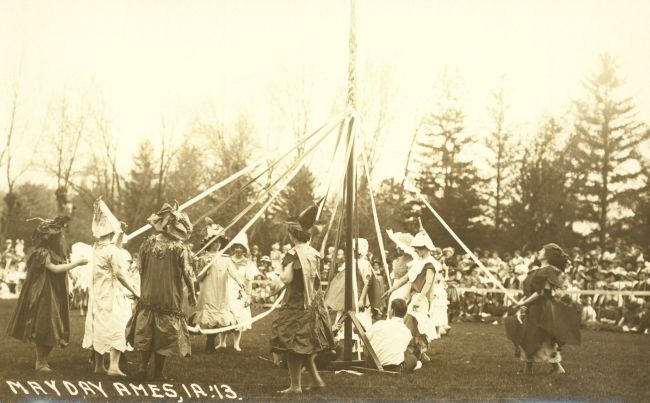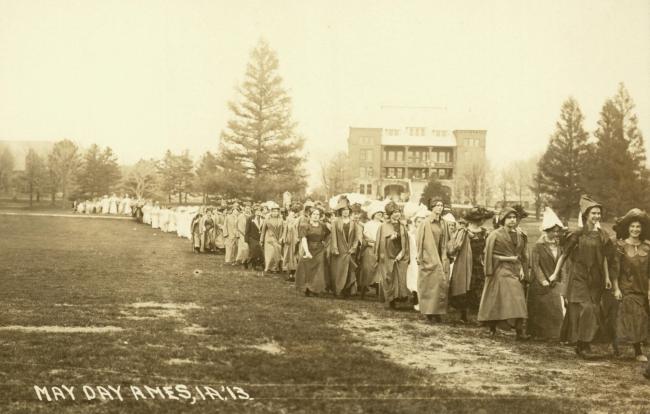Postcard photo from May 1, 1917
May Day Fete - May 1, 1917. Grecian Dance - Hortene Elliott, Helen Redhead, Norma Daniels, Gladys McCarty, Nellie VanDyke, Rhea Wahle, Bernice Wheatley, Fannie Gannon, Edythe Curtis, Alice Blundell.
A May Day pageant, picnics, and dancing around the May pole on central campus took place annually from 1907 until the festival was incorporated into the first VEISHEA in 1922. This oldest of Iowa State’s divisional celebrations honored the "senioritas," the women of the senior class. It was staged by the Women’s Athletic Association and profits from the events benefited women’s athletics. The pageant, consisting of dancing and pantomime, was usually written by the students. Above, students are performing a "Grecian dance."

Iowa State College female students chose the most accomplished senior to reign as Queen of the May. The first May Queen was Harriet Beyer (Stange). The festival was first introduced to Iowa State by Winifred Tilden, Directress of Physical Culture, who brought it from Mt. Holyoak where she attended college. Winifred was described as a no-nonsense person but fun loving and creative. She wrote and staged the first of the May Day Pageants.

(First May Day celebration)
During the past year the organization of the Woman's Athletic Association has been further perfected and improved. Miss Winifred R. Tilden, the physical director, brings much enthusiasm from her eastern Alma Mater and puts spirit and life into all departments of girls' athletics. Under her efficient management the W.A.A. on May 18, '07 gave a May Day Festival in honor of the Senioritas. This was the first affair of its kind ever attempted at Ames and its success will no doubt lead to the establishment of the pretty custom. (from the 1907-1908 ISC Bomb yearbook)

(from the 1909-1910 ISC Bomb yearbook)
This information from Past Traditions on Iowa State University's website:
May Day was held each spring in honor of the women of the senior class. Weather permitting, it was held on Central Campus, with State Gym as an alternate site in case of rain. The May event was initiated by Winifred Tilden, an Ames native and 1903 Mount Holyoke graduate who came to Iowa State in 1904 as an Instructor in Physical Culture. Miss Tilden would have observed and participated in similar "May Fetes" at Mount Holyoke, where a May Festival was held each year from 1901 to 1949.
Iowa State's first May Day was held May 18, 1907. It was sponsored by the Women's Athletic Association, an organization created for the promotion and control of women's athletics. Profits from May Day paid for equipment for women's basketball, golf, field hockey, and tennis as well as medals and letters for letter sweaters.
In the early years, May Day had an Elizabethan theme and featured dance groups like "Ye Merrie Milk Maydes" and "Ye Floral Maydens." Later productions included the "Spirits" of Scholarship, Judgment, and Leadership and "Blue Book Imps" and "Geometric Figures." Each year a senior student was chosen "May Queen." May Day was incorporated into the first VEISHEA celebration in 1922 and continued as a part of that festival through 1933.
May Day Festival of 1913
(photo courtesy of Margaret Vance)

(photo courtesy of Margaret Vance)
(photo courtesy of Margaret Vance)
From the 1912-1913 ISC Bomb yearbook
Early in the morning as dawn begins to break, low, sweet strains of music fill the air. After it is full daylight the winds and the clouds come up, followed by a heavy storm with flashes of lightning. Soon The Trumpet Flower awakens the flowers by a blast of her horn, and they appear two at a time.
In the afternoon, the sun still shines, Columbia, who has been recently crowned queen by Robin Hood, welcomes her cousins, peasant girls from Ireland, Scotland, Hungary, Italy, Holland and England. Each of them does a characteristic folk dance for the entertainment of the new queen. Some of the flower children give the Maypole dance just as the sun goes down.
Immediately after sunset, the flowers go to bed and the queen holds an informal reception for her cousins and the friends among the flowers.




